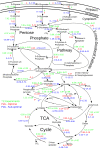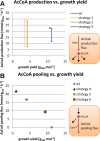Genome-scale reconstruction and analysis of the Pseudomonas putida KT2440 metabolic network facilitates applications in biotechnology
- PMID: 18974823
- PMCID: PMC2563689
- DOI: 10.1371/journal.pcbi.1000210
Genome-scale reconstruction and analysis of the Pseudomonas putida KT2440 metabolic network facilitates applications in biotechnology
Abstract
A cornerstone of biotechnology is the use of microorganisms for the efficient production of chemicals and the elimination of harmful waste. Pseudomonas putida is an archetype of such microbes due to its metabolic versatility, stress resistance, amenability to genetic modifications, and vast potential for environmental and industrial applications. To address both the elucidation of the metabolic wiring in P. putida and its uses in biocatalysis, in particular for the production of non-growth-related biochemicals, we developed and present here a genome-scale constraint-based model of the metabolism of P. putida KT2440. Network reconstruction and flux balance analysis (FBA) enabled definition of the structure of the metabolic network, identification of knowledge gaps, and pin-pointing of essential metabolic functions, facilitating thereby the refinement of gene annotations. FBA and flux variability analysis were used to analyze the properties, potential, and limits of the model. These analyses allowed identification, under various conditions, of key features of metabolism such as growth yield, resource distribution, network robustness, and gene essentiality. The model was validated with data from continuous cell cultures, high-throughput phenotyping data, (13)C-measurement of internal flux distributions, and specifically generated knock-out mutants. Auxotrophy was correctly predicted in 75% of the cases. These systematic analyses revealed that the metabolic network structure is the main factor determining the accuracy of predictions, whereas biomass composition has negligible influence. Finally, we drew on the model to devise metabolic engineering strategies to improve production of polyhydroxyalkanoates, a class of biotechnologically useful compounds whose synthesis is not coupled to cell survival. The solidly validated model yields valuable insights into genotype-phenotype relationships and provides a sound framework to explore this versatile bacterium and to capitalize on its vast biotechnological potential.
Conflict of interest statement
The authors have declared that no competing interests exist.
Figures






Similar articles
-
Integrated analysis of gene expression and metabolic fluxes in PHA-producing Pseudomonas putida grown on glycerol.Microb Cell Fact. 2016 May 3;15:73. doi: 10.1186/s12934-016-0470-2. Microb Cell Fact. 2016. PMID: 27142075 Free PMC article.
-
A genome-scale metabolic reconstruction of Pseudomonas putida KT2440: iJN746 as a cell factory.BMC Syst Biol. 2008 Sep 16;2:79. doi: 10.1186/1752-0509-2-79. BMC Syst Biol. 2008. PMID: 18793442 Free PMC article.
-
In silico genome-scale metabolic analysis of Pseudomonas putida KT2440 for polyhydroxyalkanoate synthesis, degradation of aromatics and anaerobic survival.Biotechnol J. 2010 Jul;5(7):739-50. doi: 10.1002/biot.201000124. Biotechnol J. 2010. PMID: 20540110
-
Pseudomonas putida as a functional chassis for industrial biocatalysis: From native biochemistry to trans-metabolism.Metab Eng. 2018 Nov;50:142-155. doi: 10.1016/j.ymben.2018.05.005. Epub 2018 May 16. Metab Eng. 2018. PMID: 29758287 Review.
-
Industrial biotechnology of Pseudomonas putida: advances and prospects.Appl Microbiol Biotechnol. 2020 Sep;104(18):7745-7766. doi: 10.1007/s00253-020-10811-9. Epub 2020 Aug 13. Appl Microbiol Biotechnol. 2020. PMID: 32789744 Free PMC article. Review.
Cited by
-
Integrated analysis of gene expression and metabolic fluxes in PHA-producing Pseudomonas putida grown on glycerol.Microb Cell Fact. 2016 May 3;15:73. doi: 10.1186/s12934-016-0470-2. Microb Cell Fact. 2016. PMID: 27142075 Free PMC article.
-
Inferring ancient metabolism using ancestral core metabolic models of enterobacteria.BMC Syst Biol. 2013 Jun 11;7:46. doi: 10.1186/1752-0509-7-46. BMC Syst Biol. 2013. PMID: 23758866 Free PMC article.
-
Analysis of genetic variation and potential applications in genome-scale metabolic modeling.Front Bioeng Biotechnol. 2015 Feb 16;3:13. doi: 10.3389/fbioe.2015.00013. eCollection 2015. Front Bioeng Biotechnol. 2015. PMID: 25763369 Free PMC article. Review.
-
Regulatory tasks of the phosphoenolpyruvate-phosphotransferase system of Pseudomonas putida in central carbon metabolism.mBio. 2012 Mar 20;3(2):e00028-12. doi: 10.1128/mBio.00028-12. Print 2012. mBio. 2012. PMID: 22434849 Free PMC article.
-
Comparative genomics and functional analysis of niche-specific adaptation in Pseudomonas putida.FEMS Microbiol Rev. 2011 Mar;35(2):299-323. doi: 10.1111/j.1574-6976.2010.00249.x. FEMS Microbiol Rev. 2011. PMID: 20796030 Free PMC article. Review.
References
-
- Timmis KN. Pseudomonas putida: a cosmopolitan opportunist par excellence. Environ Microbiol. 2002;4:779–781. - PubMed
-
- dos Santos VAPM, Heim S, Moore ERB, Stratz M, Timmis KN. Insights into the genomic basis of niche specificity of Pseudomonas putida KT2440. Environ Microbiol. 2004;6:1264–1286. - PubMed
-
- Moore ERB, Tindall BJ, Martins dos Santos VAP, Pieper DH, Ramos JL, et al. Nonmedical: Pseudomonas. In: Dworkin M, Falkow S, Rosenberg E, Schleifer K, Stackebrandt E, editors. The Prokaryotes: A Handbook on the Biology of Bacteria. New York: Springer; 2006. pp. 646–703.
-
- Mosqueda G, Ramos-Gonzalez MI, Ramos JL. Toluene metabolism by the solvent-tolerant Pseudomonas putida DOT-T1 strain, and its role in solvent impermeabilization. Gene. 1999;232:69–76. - PubMed
-
- de Bont JAM. Solvent-tolerant bacteria in biocatalysis. Trends Biotechnol. 1998;16:493–499.
Publication types
MeSH terms
Substances
LinkOut - more resources
Full Text Sources
Molecular Biology Databases

